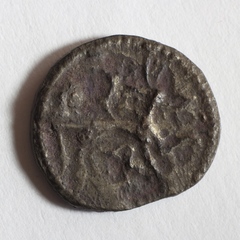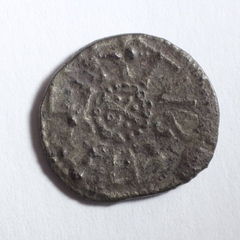- Silver sceatta coin dated to the middle decades of the 8th Century AD depicting a four-legged beast on one side, and 'eadbertus' on the other.
Interpretation
-
- A silver coin with a four-legged beast on one side, and 'eadbertus' on the other. It has been identified by Dr. John Naylor as a silver sceat of King Eadbhert (king of Northumbria AD37-58). More specifically, it is a Booth's Class F coin of Eadbhert's coinage with an unusual back-to-front S, which narrows it down to a specific issue in the middle decades of the 8th century. It is in good condition, but is well-worn, suggesting it may have remained in circulation for some time.
-
- Johanna Ungemach
- 23-2-2017
-
- BY JOHN NAYLOR (Portable Antiquities Scheme (www.finds.org.uk) National Finds Advisor for Post-Roman Coinage. Ashmolean Museum Lindisfarne 2016 excavations Report on coin find John Naylor (Ashmolean Museum, University of Oxford) Type: A silver sceat of Secondary Phase Series Y issued by Eadberht of Northumbria (737-c.758), Booth Class F; Pirie Class Aii Obverse: King’s name around a central beaded circle containing a cross with pellet in each angle Obverse inscription: EOTBERHTVS (square O; reverse S) Reverse: Beast facing right, triquetra beneath body Weight: 0.675 g Diameter: 13.8 mm Thickness: 1.25 mm Die Axis: (from image) 180o (will need to be checked) Discussion The coin found during the 2016 excavation belongs to Booth’s Class F of Eadberht’s coinage (Booth 1984: 93-4, fig. 1) dating to the middle decades of the 8th century, one of the smaller groups within Eadberht’s issues. The reversed S in the obverse inscription is unusual, although not entirely unknown with a Class F coin from the Whithorn excavations shows the same, albeit with a different central motif (Metcalf 1994: 586). The coin appears to be in generally good condition, and is worn in appearance suggesting it may have been in circulation for a reasonable period of time before deposition. This is not the first early-medieval coin to be discovered on Holy Island. Excavations in Holy Island village produced another sceat of Eadberht – of Booth Class A – which was a residual find in a later medieval pit, and may have circulated for some time given its worn state (O’Sullivan 1985: 112). At the north side of the island at Green Shiel, early-medieval buildings dating to the 9th century were excavated during the 1980s, although finds were originally made in the 19th century. These Victorian finds included two mid 9th-century Northumbrian stycas (a predominantly copper-alloy coinage) of Æthelred II (841-9) and Archbishop Wigmund (837-54) (O’Sullivan and Young 1991: 55). The later excavations of three buildings with stone foundations uncovered six stycas from building A and two stycas, the latter one each of Eanred (810-41) and Æthelred II, plus a broad flan silver penny of Æthelred of Wessex (866-71), a very rare find this far north, from Building C. Elsewhere in Eastern Britain north of the River Tyne, finds of early-medieval coinage are rare. Various excavations at Bamburgh Castle and its environs have recovered numerous stycas, including at least 67 from Brian Hope-Taylor’s excavations A hoard of over 300 stycas was found by metal-detectorists between 1999 and 2002 (Pirie 2004), and another hoard of at least 125 stycas was found during excavations at the castle in 2009. A hoard of thousands of stycas was found at Hexham in the mid-19th century. A very small number of stycas have been reported to PAS from Northumberland. A series Y sceat of Eadberht and 11 stycas have also been found at Aberlady ((East Lothian) and were reported to EMC. References Metcalf, D M (1994), Thrymsas and Sceattas in the Ashmolean Museum volume 3, London: Royal Numismatic Society & Ashmolean Museum. O’Sullivan, D M (1985), ‘An excavation in Holy Island village, 1977’, Archaeologia Aeliana 5th series XIII, 27-116. O’Sullivan, D M and Young, R (1991), ‘The early-medieval settlement at Green Shiel, Northumberland’, Archaeologia Aeliana 5th series XIX, 55-69. Pirie, E J E (2004), ‘The Bamburgh hoard of ninth-century Northumbrian coins’, Archaeologia Aeliana 5th series XXXIII,65-75.
-
- David Petts
- 3-5-2017
3-D Models
- No models found for this item
Comments
- A silver sceat of Secondary Phase Series Y issued by Eadberht of Northumbria (737-c.758), Booth Class F; Pirie Class Aii. 1 fragment, 0.675 g. Diameter - 13.8 mm Thickness - 1.25 mm
From Context
-
Context: LDF_1004
- Nigel Steel 22-6-2016



